instrument panel SSANGYONG KORANDO 2012 Service Manual
[x] Cancel search | Manufacturer: SSANGYONG, Model Year: 2012, Model line: KORANDO, Model: SSANGYONG KORANDO 2012Pages: 1082, PDF Size: 96.1 MB
Page 554 of 1082

02-16
2) Interior Fuse Box
The interior fuse box is located in the left side of the instrument panel. To remove this fuse box,
disconnect the main wiring first.
Capacity and name of interior fuse and relay ▶
Page 564 of 1082

02-26
3) ICM Box
The ICM box is installed on the back side of the instrument panel.
Arrangement of connectors and relays ▶
Page 585 of 1082

03-198710-01
Speed sensitive intermittent wiper ▶
The BCM without rain sensor operates the wiper as follows:
When turning the ignition switch to ON from OFF position with the intermittent wiper switch in "ON"
position, the wipers do not operate.
When turning the wiper switch to ON from OFF position after turning the ignition switch to ON position,
the wipers operate one cycle.
The wiper's operation cycle depends on the vehicle speed (CAN communication with instrument
cluster) and wiping speed the side fascia panel.
<0054004700760097008c00990088009b0090009600950047008a00a0008a0093008c00610047005a00b700570055005c0047009a008c008a0047004f006d0068007a007b00500047009b009600470058006000b700590047009a008c008a0047004f007a00
730076007e0050> 1.
2.
3.
Page 714 of 1082
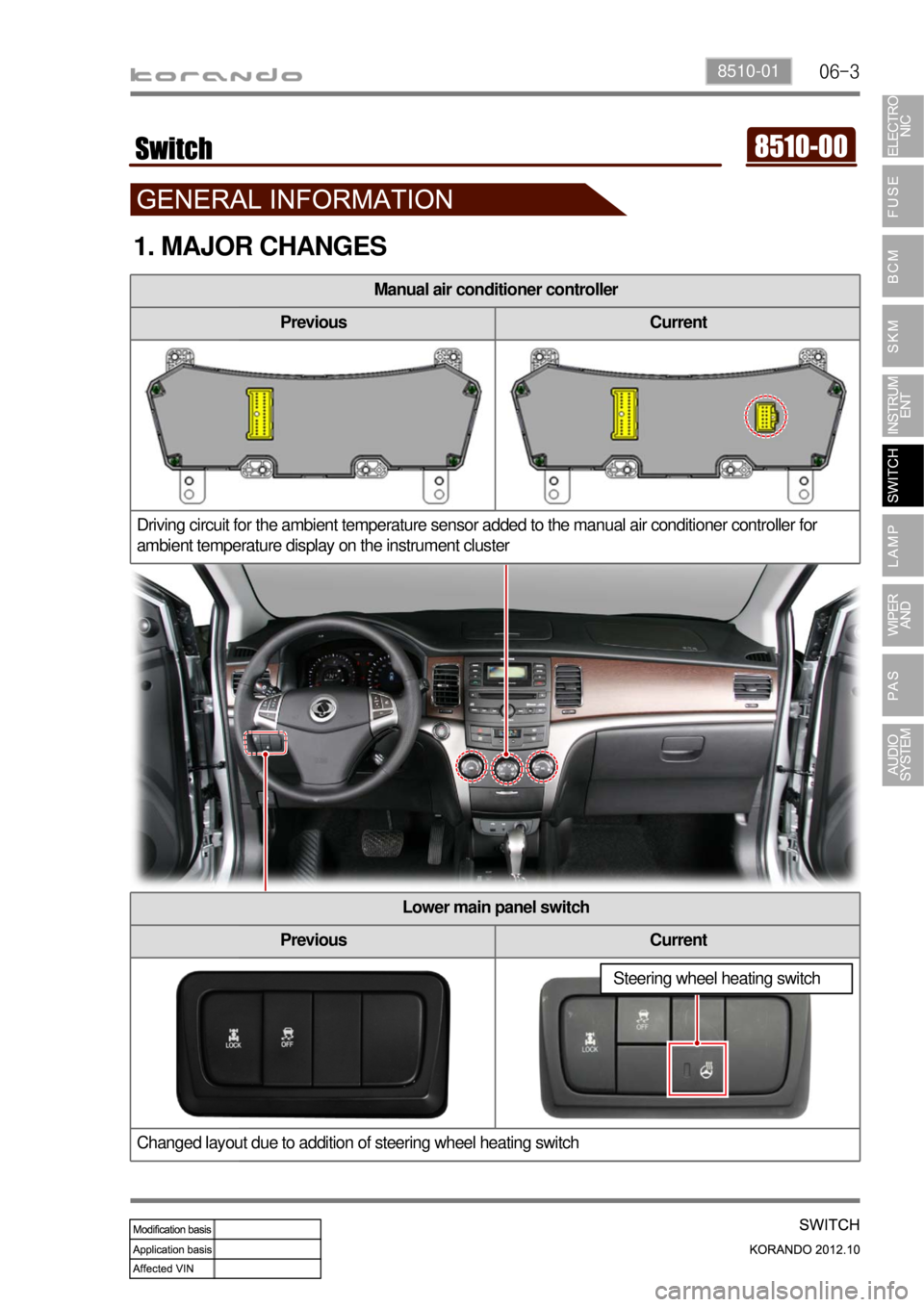
06-38510-01
1. MAJOR CHANGES
Manual air conditioner controller
Previous Current
Driving circuit for the ambient temperature sensor added to the manual air conditioner controller for
ambient temperature display on the instrument cluster
Lower main panel switch
Previous Current
Changed layout due to addition of steering wheel heating switch
Steering wheel heating switch
Page 730 of 1082

06-198510-00
FATC switch
1) FATC Switches
Air source mode switch
Temperature dial
Mode dialFan speed dial
A/C switch
In-car temperature sensor
3. SWITCH CLUSTER ON INSTRUMENT PANEL
Page 793 of 1082
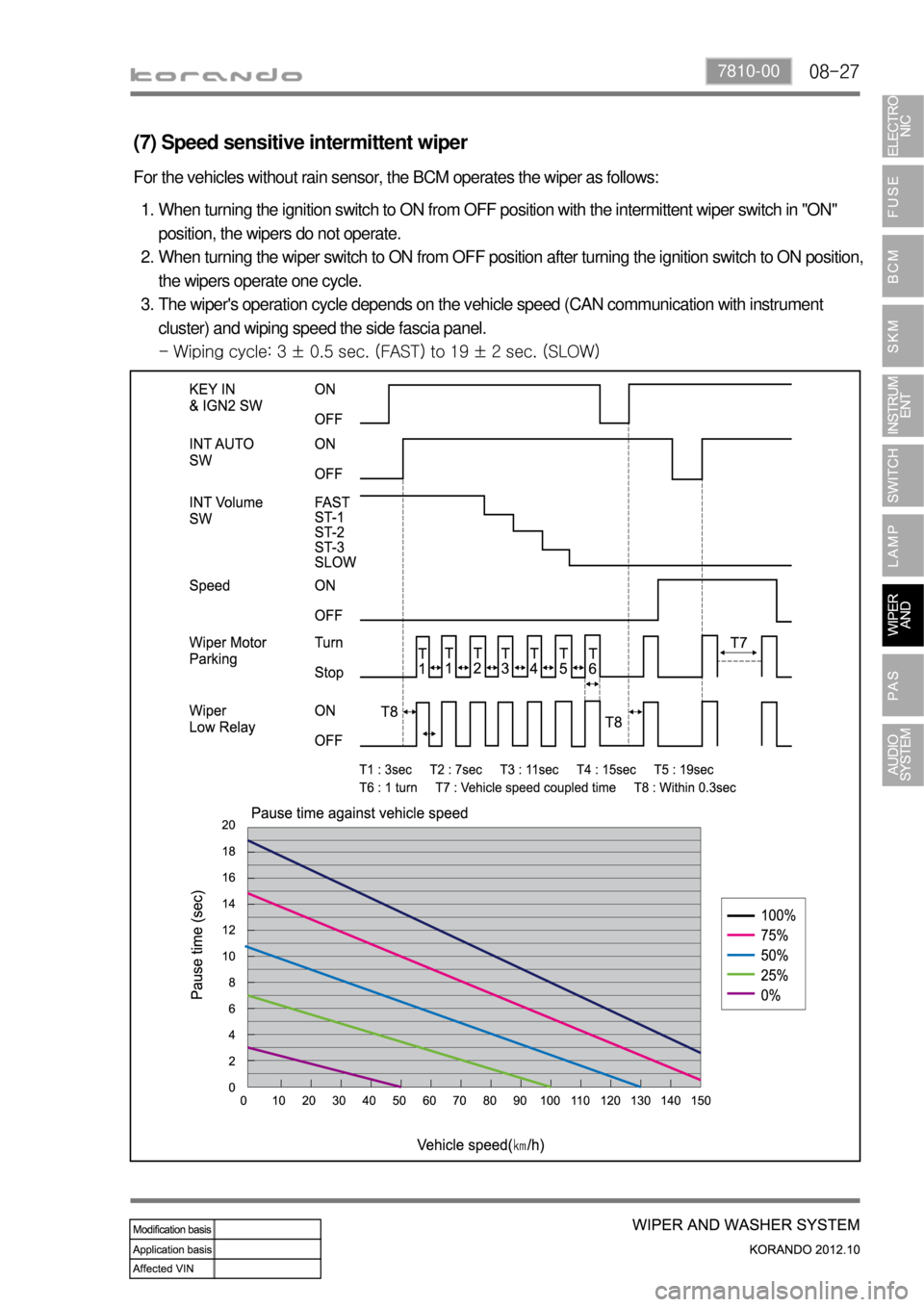
08-277810-00
For the vehicles without rain sensor, the BCM operates the wiper as follows:
When turning the ignition switch to ON from OFF position with the intermittent wiper switch in "ON"
position, the wipers do not operate.
When turning the wiper switch to ON from OFF position after turning the ignition switch to ON position,
the wipers operate one cycle.
The wiper's operation cycle depends on the vehicle speed (CAN communication with instrument
cluster) and wiping speed the side fascia panel.
<00540047007e0090009700900095008e0047008a00a0008a0093008c00610047005a004700b7004700570055005c0047009a008c008a00550047004f006d0068007a007b00500047009b0096004700580060004700b7004700590047009a008c008a005500
47004f007a00730076007e0050> 1.
2.
3.
(7) Speed sensitive intermittent wiper
Page 959 of 1082
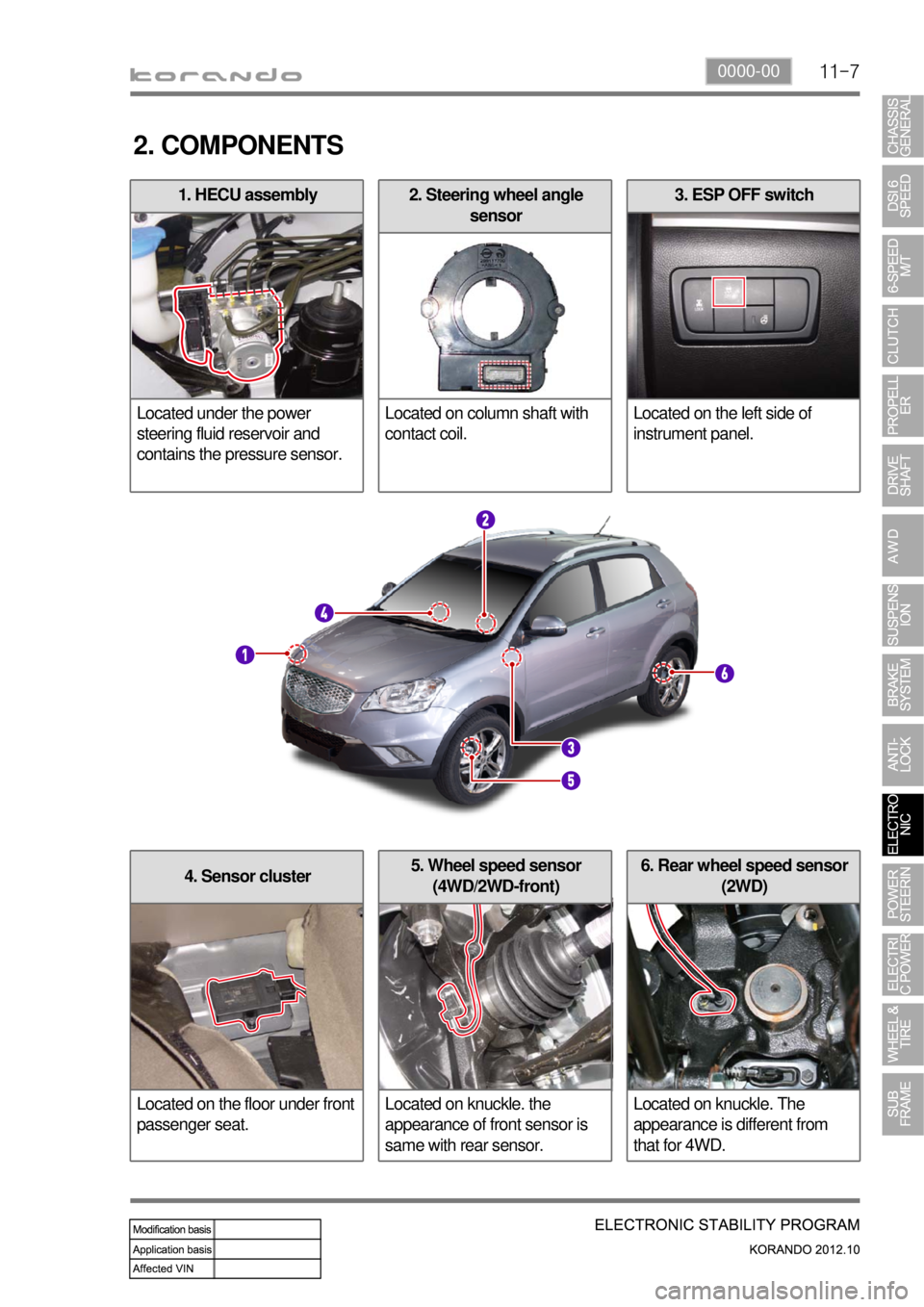
11-70000-00
3. ESP OFF switch
Located on the left side of
instrument panel.2. Steering wheel angle
sensor
Located on column shaft with
contact coil.1. HECU assembly
Located under the power
steering fluid reservoir and
contains the pressure sensor.
2. COMPONENTS
4. Sensor cluster
Located on the floor under front
passenger seat.5. Wheel speed sensor
(4WD/2WD-front)
Located on knuckle. the
appearance of front sensor is
same with rear sensor.6. Rear wheel speed sensor
(2WD)
Located on knuckle. The
appearance is different from
that for 4WD.
Page 960 of 1082
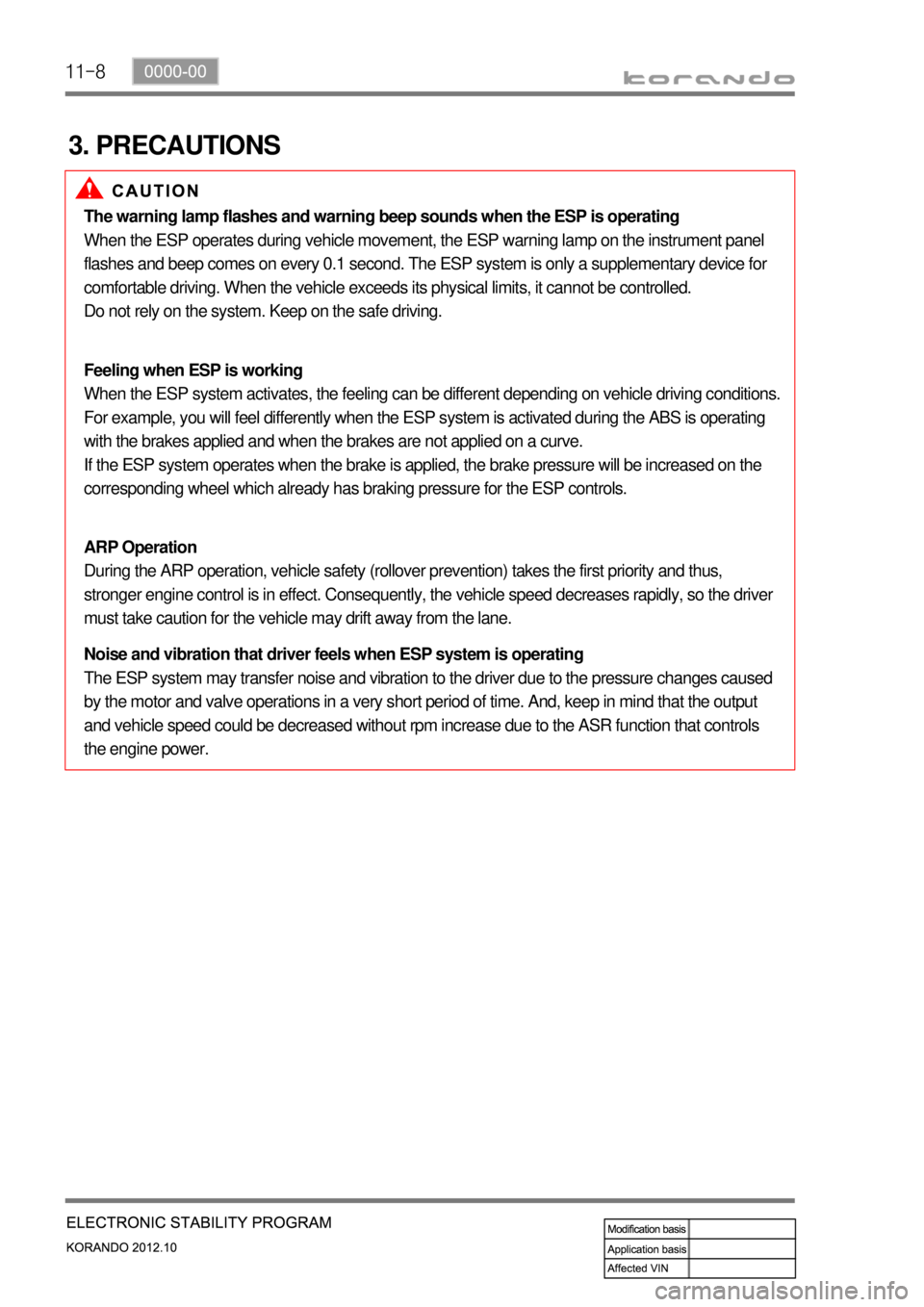
11-8
3. PRECAUTIONS
The warning lamp flashes and warning beep sounds when the ESP is operating
When the ESP operates during vehicle movement, the ESP warning lamp on the instrument panel
flashes and beep comes on every 0.1 second. The ESP system is only a supplementary device for
comfortable driving. When the vehicle exceeds its physical limits, it cannot be controlled.
Do not rely on the system. Keep on the safe driving.
Feeling when ESP is working
When the ESP system activates, the feeling can be different depending on vehicle driving conditions.
For example, you will feel differently when the ESP system is activated during the ABS is operating
with the brakes applied and when the brakes are not applied on a curve.
If the ESP system operates when the brake is applied, the brake pressure will be increased on the
corresponding wheel which already has braking pressure for the ESP controls.
ARP Operation
During the ARP operation, vehicle safety (rollover prevention) takes the first priority and thus,
stronger engine control is in effect. Consequently, the vehicle speed decreases rapidly, so the driver
must take caution for the vehicle may drift away from the lane.
Noise and vibration that driver feels when ESP system is operating
The ESP system may transfer noise and vibration to the driver due to the pressure changes caused
by the motor and valve operations in a very short period of time. And, keep in mind that the output
and vehicle speed could be decreased without rpm increase due to the ASR function that controls
the engine power.
Page 973 of 1082
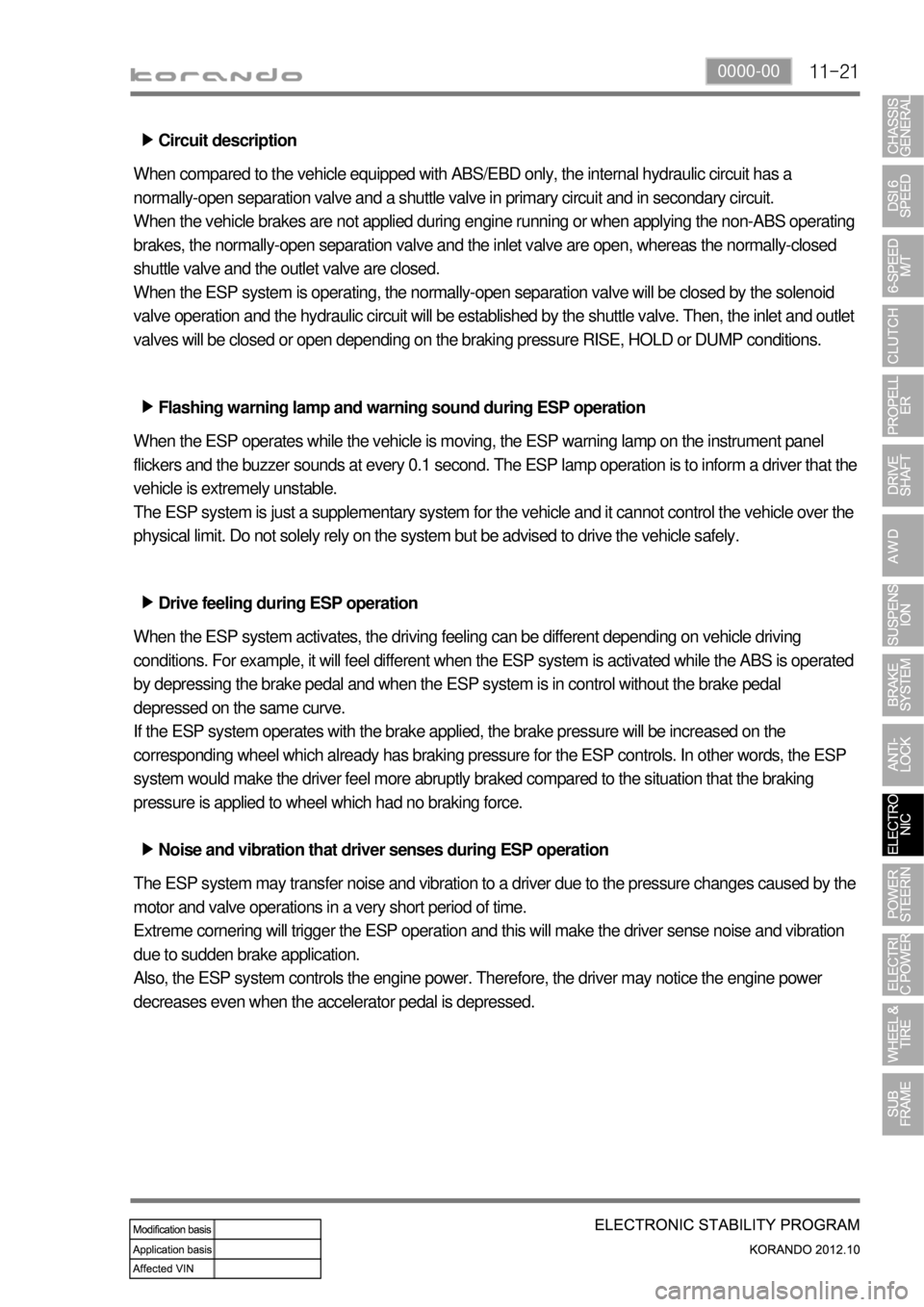
11-210000-00
Circuit description ▶
When compared to the vehicle equipped with ABS/EBD only, the internal hydraulic circuit has a
normally-open separation valve and a shuttle valve in primary circuit and in secondary circuit.
When the vehicle brakes are not applied during engine running or when applying the non-ABS operating
brakes, the normally-open separation valve and the inlet valve are open, whereas the normally-closed
shuttle valve and the outlet valve are closed.
When the ESP system is operating, the normally-open separation valve will be closed by the solenoid
valve operation and the hydraulic circuit will be established by the shuttle valve. Then, the inlet and outlet
valves will be closed or open depending on the braking pressure RISE, HOLD or DUMP conditions.
Flashing warning lamp and warning sound during ESP operation ▶
When the ESP operates while the vehicle is moving, the ESP warning lamp on the instrument panel
flickers and the buzzer sounds at every 0.1 second. The ESP lamp operation is to inform a driver that the
vehicle is extremely unstable.
The ESP system is just a supplementary system for the vehicle and it cannot control the vehicle over the
physical limit. Do not solely rely on the system but be advised to drive the vehicle safely.
Drive feeling during ESP operation ▶
When the ESP system activates, the driving feeling can be different depending on vehicle driving
conditions. For example, it will feel different when the ESP system is activated while the ABS is operated
by depressing the brake pedal and when the ESP system is in control without the brake pedal
depressed on the same curve.
If the ESP system operates with the brake applied, the brake pressure will be increased on the
corresponding wheel which already has braking pressure for the ESP controls. In other words, the ESP
system would make the driver feel more abruptly braked compared to the situation that the braking
pressure is applied to wheel which had no braking force.
Noise and vibration that driver senses during ESP operation ▶
The ESP system may transfer noise and vibration to a driver due to the pressure changes caused by the
motor and valve operations in a very short period of time.
Extreme cornering will trigger the ESP operation and this will make the driver sense noise and vibration
due to sudden brake application.
Also, the ESP system controls the engine power. Therefore, the driver may notice the engine power
decreases even when the accelerator pedal is depressed.
Page 1019 of 1082
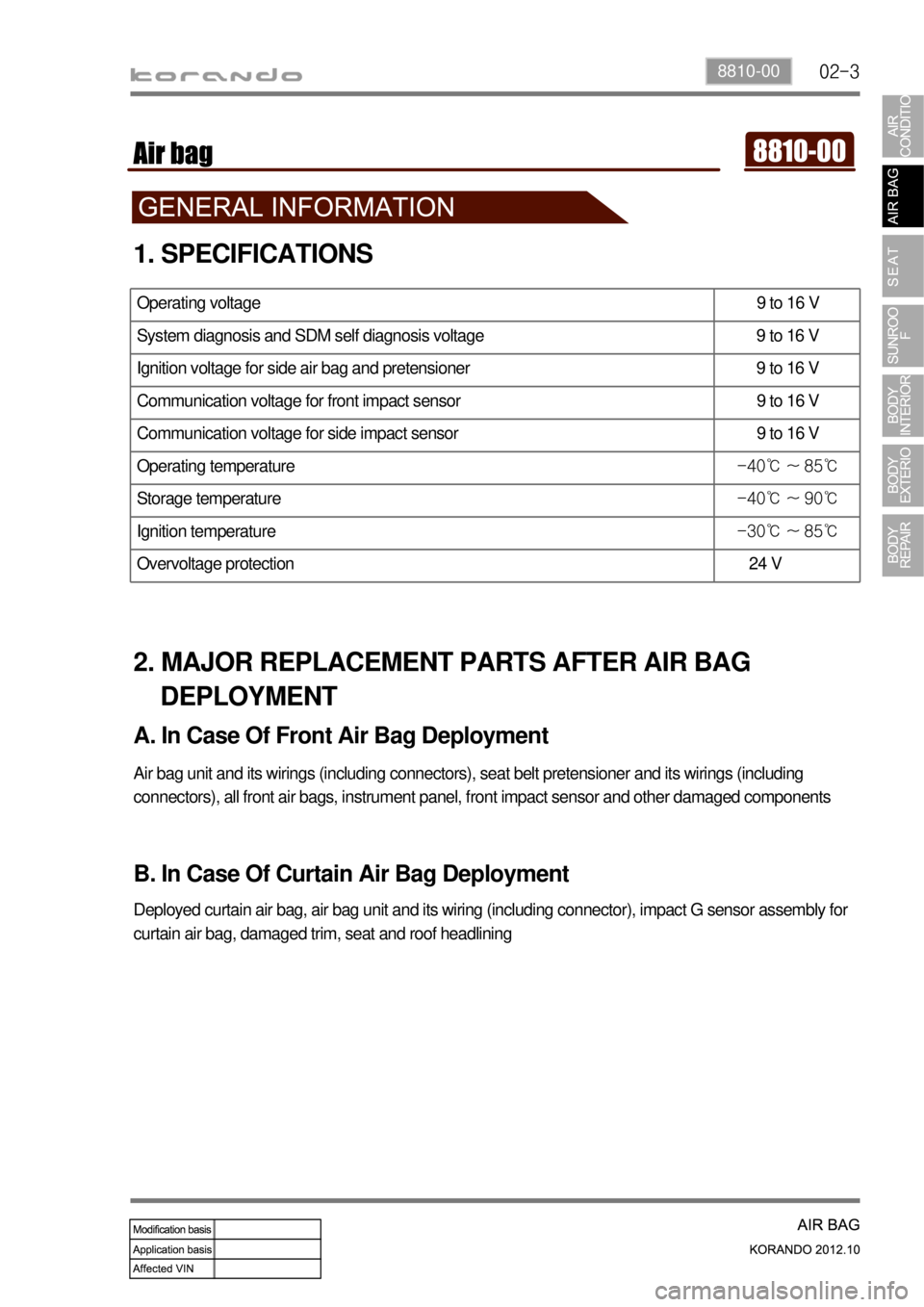
02-38810-00
1. SPECIFICATIONS
Operating voltage 9 to 16 V
System diagnosis and SDM self diagnosis voltage 9 to 16 V
Ignition voltage for side air bag and pretensioner 9 to 16 V
Communication voltage for front impact sensor 9 to 16 V
Communication voltage for side impact sensor 9 to 16 V
Operating temperature -40℃ ~ 85℃
Storage temperature -40℃ ~ 90℃
Ignition temperature -30℃ ~ 85℃
Overvoltage protection 24 V
2. MAJOR REPLACEMENT PARTS AFTER AIR BAG
DEPLOYMENT
A. In Case Of Front Air Bag Deployment
Air bag unit and its wirings (including connectors), seat belt pretensioner and its wirings (including
connectors), all front air bags, instrument panel, front impact sensor and other damaged components
B. In Case Of Curtain Air Bag Deployment
Deployed curtain air bag, air bag unit and its wiring (including connector), impact G sensor assembly for
curtain air bag, damaged trim, seat and roof headlining